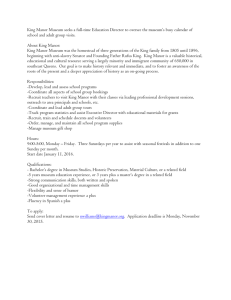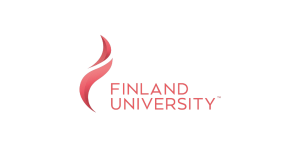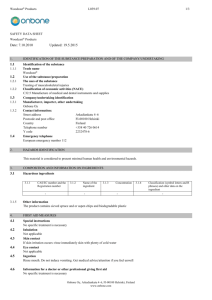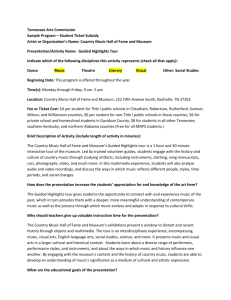to Spectacular Tour of the Nordic - 20
advertisement
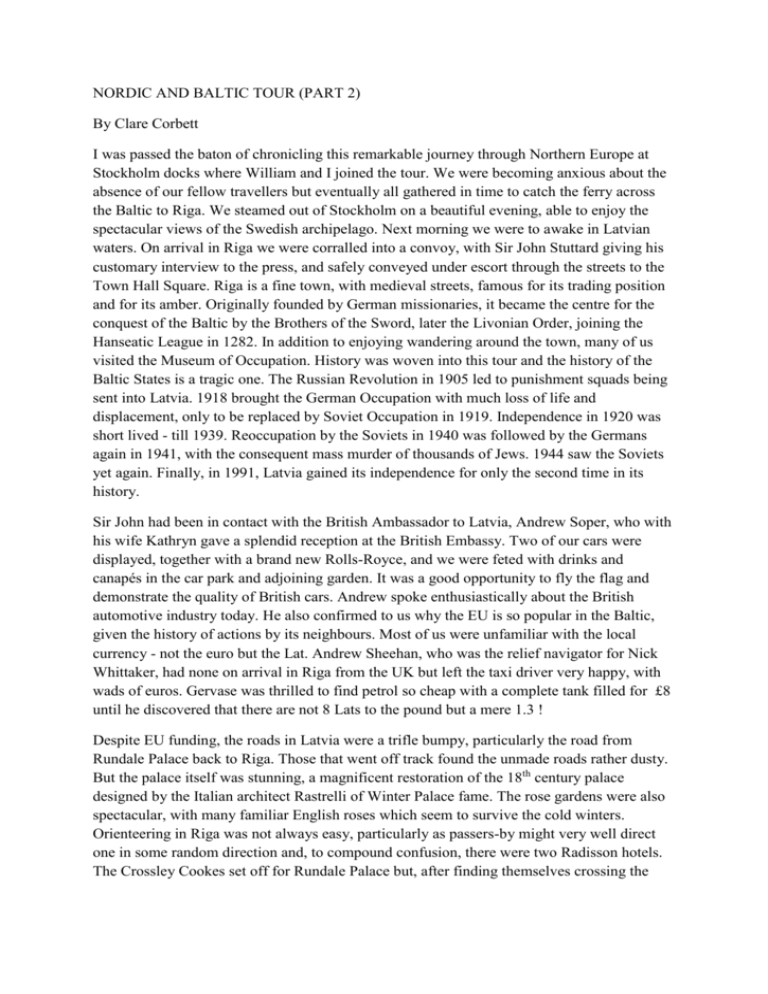
NORDIC AND BALTIC TOUR (PART 2) By Clare Corbett I was passed the baton of chronicling this remarkable journey through Northern Europe at Stockholm docks where William and I joined the tour. We were becoming anxious about the absence of our fellow travellers but eventually all gathered in time to catch the ferry across the Baltic to Riga. We steamed out of Stockholm on a beautiful evening, able to enjoy the spectacular views of the Swedish archipelago. Next morning we were to awake in Latvian waters. On arrival in Riga we were corralled into a convoy, with Sir John Stuttard giving his customary interview to the press, and safely conveyed under escort through the streets to the Town Hall Square. Riga is a fine town, with medieval streets, famous for its trading position and for its amber. Originally founded by German missionaries, it became the centre for the conquest of the Baltic by the Brothers of the Sword, later the Livonian Order, joining the Hanseatic League in 1282. In addition to enjoying wandering around the town, many of us visited the Museum of Occupation. History was woven into this tour and the history of the Baltic States is a tragic one. The Russian Revolution in 1905 led to punishment squads being sent into Latvia. 1918 brought the German Occupation with much loss of life and displacement, only to be replaced by Soviet Occupation in 1919. Independence in 1920 was short lived - till 1939. Reoccupation by the Soviets in 1940 was followed by the Germans again in 1941, with the consequent mass murder of thousands of Jews. 1944 saw the Soviets yet again. Finally, in 1991, Latvia gained its independence for only the second time in its history. Sir John had been in contact with the British Ambassador to Latvia, Andrew Soper, who with his wife Kathryn gave a splendid reception at the British Embassy. Two of our cars were displayed, together with a brand new Rolls-Royce, and we were feted with drinks and canapés in the car park and adjoining garden. It was a good opportunity to fly the flag and demonstrate the quality of British cars. Andrew spoke enthusiastically about the British automotive industry today. He also confirmed to us why the EU is so popular in the Baltic, given the history of actions by its neighbours. Most of us were unfamiliar with the local currency - not the euro but the Lat. Andrew Sheehan, who was the relief navigator for Nick Whittaker, had none on arrival in Riga from the UK but left the taxi driver very happy, with wads of euros. Gervase was thrilled to find petrol so cheap with a complete tank filled for £8 until he discovered that there are not 8 Lats to the pound but a mere 1.3 ! Despite EU funding, the roads in Latvia were a trifle bumpy, particularly the road from Rundale Palace back to Riga. Those that went off track found the unmade roads rather dusty. But the palace itself was stunning, a magnificent restoration of the 18th century palace designed by the Italian architect Rastrelli of Winter Palace fame. The rose gardens were also spectacular, with many familiar English roses which seem to survive the cold winters. Orienteering in Riga was not always easy, particularly as passers-by might very well direct one in some random direction and, to compound confusion, there were two Radisson hotels. The Crossley Cookes set off for Rundale Palace but, after finding themselves crossing the same bridge in different directions and after negotiating the many road works in Riga, repaired back to the hotel for an alternative day of relative leisure. Neatly meshing history and motoring was the visit to The Riga Motor Museum. We were welcomed by the founder, Viktors Kulbergs, President of the Antique Automobile Club of Latvia, who established the museum in 1989. He pointed out that the design of the front of the building incorporates the Rolls-Royce radiator which, at one stage, but now no longer, had been the source of some contention. Inside the museum, we had a journey through Latvian motoring history. There were hosts of Soviet cars, including the Kremlin collection with a strong preference for large and American vehicles. The Lincoln Continental in midnight blue was a gift from Nixon to Brezhnev (a bit of a petrol-head) in 1973. A life size model of Stalin was sitting in the back of his favourite Packard limousine with its 3” thick armoured body and windows. More sinister was the wax model of Brezhnev looking aghast and sitting in the smashed Rolls-Royce Silver Shadow which he crashed while driving in Moscow in 1980. The official Kremlin version for his absence with injuries was that he was suffering from “flu.” During the difficult years, Latvian copies were made of many motor cars using wood with metal appliqué. There was even a car with a wood fired boiler. The star exhibit was the 1938 Auto Union C/D mountain climbing racing car which the Russians had taken from Germany at the end of the Second World War. It is the only one of its type left in the world and was rescued from near destruction by Mr Kulbergs. We were allowed to look under the bonnet of this extraordinary car - a beautiful sight for racing car aficionados. Next stop on our Nordic and Baltic tour was Estonia, via the restored 13th century Turaida Castle on the banks of Latvia’s Gauja River. With EU money, the roads improved. Our destination was the beach resort and spa town of Parnu. The hotel we stayed in was the Hotel Ammende Villa, built in 1904 by a German merchant for his daughter’s wedding, as there was nothing in Parnu grand enough to suit the occasion. Graham and Sarah Tyson, with a family marriage on the cards, were noting this but not planning to emulate him. The nearest beach we attempted to explore was clearly marked “For Ladies Only” and “Beware Nudity”. Some of the ladies on display were indeed ones to be wary of. There was talk of mechanical engineering but even our tour engineer, Roy O ‘Sullivan, who is apparently partial to a morning swim, heeded the notices, although he may well have been dissuaded by the weather, which was truly torrential rain. However the rain eased for the concert in the hotel’s parkland garden by Estonia’s most famous singers, including Tonis Magi who played at the country’s Independence celebrations in 1991. Roland and Kimberley were particularly enchanted by the music and bought the CD. Others were more occupied in enjoying the delicious dinner on the terrace of the hotel. Indoors, we enjoyed drinks in the Art Nouveau styled rooms. Fokko Keuning was more interested in the hotel’s magnificent moose heads, which looked suitably morose, but he declined the challenge of detaching the golden eagle from the grand chandelier in the grand hallway. Fokko collects stuffed birds and, in Denmark, he had acquired a rare black grouse, which was perched in the back seat of his Phantom II Continental and which had been admired with interest through the rear window. Music at Parnu was a taster for the next musical extravaganza of Estonian folkloric music and dancing around a barbeque at our next hotel, Vihula Manor, an18th century Estonian manor house situated by a river, with its own water mill. The hotel complex is owned by a group of businessmen, including Englishman Paul Taylor whose taste is reflected in the choice of his car - a Derby Bentley. His business partner, Mike Pilkington, also joined us in his British classic sports car. The folkloric band was led by a smiling female martinet who had Sir John dancing extravagantly and, in the fashion of Estonian dancing, bumping bottoms with a considerably larger posterior than his own. Our martinet had most of us joining in, with Nick Whittaker playing the saucepans, Christine Turner showing us how to dance and even Michael Elliott was seen tapping a plate, all in perfect time. Forests are of crucial importance to Nordic and Baltic prosperity and folklore. On our route to Vihula we stopped at the 16th century Eivere Manor, which had been recently bought by a Japanese businessman. After trading in timber and other forest products, he is now planning to make noodles, using the pure water in the area of the manor. Vihula Manor was set in Lahemaa National Park and the roads through the forest make for easy driving with very little traffic, apart from some hotspots which one soon leaves behind. Some of our group visited Sagadi Manor, built in the 1750s by a Swedish baronial family, the von Focks, in baroque style. In the main courtyard was the Museum of Forestry, with interesting displays of wooden work, types of trees and displays on the importance of the forest spirits. This could be the origin of the question, which was posed when our plain radiator cap was on the car, “who has pinched your fairy”. Our forest journeys led to the ruined, originally Cistercian, Kolga Manor once the largest estate in Estonia with 50,000 hectares. Now with hardly any hectares, a big restoration bill and a price tag of 1.5 million euros, it is looking for a loving buyer to renovate the ruin. Then, we travelled westwards to Tallinn and a further confluence of water and history - downpours and a magnificent maritime history. We stayed at the von Stackelberg Hotel, an old city mansion and now a bijoux hotel. It was a great base from which to explore the charms of the old town. In 1285 Tallinn became the northernmost member of the Hanseatic League and in 1563 Estonia became part of Sweden. Despite much pillage and razing over the years, Tallinn has now been beautifully restored, with fine churches and medieval buildings. In the 13th century, the magnificent St Olav’s church was apparently the tallest building in the world. Sir John had secured further ambassadorial input from British Ambassador Chris Holtby, who had kindly organised a guided tour (with coffee and excellent cakes) to the newly opened Maritime Museum set on the waterfront in the old seaplane hangars. A selection of Rolls-Royces hazarded the weather, to be photographed in front of the museum but by the time the last photographer had appeared only Bernard Holmes’ Red Ghost remained. He sportingly left his car outside the museum for further photographers, while he, Sylvia and Christine went sightseeing. Our museum guide was anxious to find out, after our tour, if our group had been paying attention. From the answers she received, Clayton Banks was easily top of the class. He was able to recite such detailed facts as the thickness of the concrete shell (8cm) of the seaplane hangars and other equally testing questions until he was shouted down by the rest of the class for being teacher’s pet ! The queue to see around the interior of the 1936 British built submarine, Lembik, was too long for us to see what life might have been like in a small submarine, but the other exhibits were fascinating, not least the ice–surfers which, with speeds of 150kmh and no brakes, appealed to the speed merchants in our party. The final country we visited on our five country Nordic and Baltic tour was Finland. Approaching by ferry from Tallinn, we reached Helsinki docks, where Sir John was again besieged by the Press and TV, before we processed in an orderly convoy, under Police escort, to a car park in the fashionable Kaivopuisto Park near to the Café Ursula, our lunch spot. Our thank go to the Helsinki Police Department for arranging this. The sun shone, the cars behaved beautifully, and we were joined by local vintage car enthusiasts, including Philip Aminoff, who had helped with the organisation of the Finnish leg of our tour, Ilkka Brotherus and Bernt Ehrnrooth, the last of whom drove his great grandfather’s Silver Ghost. A magnificent machine, the chassis was off-test in 1921 and the car was rebodied in 1927 in Sweden. Fascinatingly, the controls are in French hence “Huile” and “Essence”. Roland Duce reckoned it may have once been a show car in a Paris Exhibition. After a fine lunch, with views out to sea, it was time for another history lesson during a visit to the home of Finland’s famous war time hero, Marshal Mannerheim. Once in the Tsarist Army and present in the honour guard at the Coronation of the last Tsar, Baron Mannerheim rose to become President of Finland in 1944. He knew everybody who was anybody and his achievements were evident at the museum, with memorabilia and hundreds of decorations, medals and insignias to prove it. Churchill even sent him cigars during the war despite Finland siding with Nazi Germany after being invaded by the Soviet Union. And, of course, in addition to all those medals and an MCC tie, he owned a Rolls-Royce! So detailed was our tour of Mannerheim’s home that many of us can now quote his height, foot size and even the desired temperature of his bath water. To prove it and for those of you who missed that part of the tour, the measurements are 1.86m, size 43 and 18 degrees centigrade, respectively. From Helsinki we drove in light rain on a good motorway, but with some road works (the Finns repair their roads in the summer, when they are not snowbound) westwards into the countryside, to Svartå Manor. The manor includes a hotel in several buildings, managed by Filip and Chris Linder. The main house was built in the 18th century by the baronial Linder family and the estate is now back in family hands after a short interlude being owned by a Finnish forest industry company. Here, once again, forestry and iron were the source of the fortune that built this splendid house, now a museum. It has many fine paintings and furniture, including a painting of King Gustav III of Sweden who, according to the guide, had donated it to the family in grateful thanks for hosting one of his pregnant mistresses. He died without legitimate issue, but had 17 illegitimate offspring; so we assume there are many grand houses in the Nordic countries with fine portraits of the king. In his day, Baron Hjalmar de Linder was the wealthiest man in Finland and had a lifestyle to prove it. He owned a 1914 Rolls Royce which he apparently purchased from under the nose of King Leopold of Belgium - complete with driver and driver’s wife. The local forest people thought he must have been consorting with the devil when it appeared as it was the first car to arrive in Finland. His sister, described in her passport as “Of extraordinary facial beauty”, was an attraction to the great Marshal Mannerheim, who visited the de Linders for hunting expeditions at which he was consummately skilled, but she refused to marry him as he was, in her words, “too boring.” What an awful remark to make about Finland’s national hero. By the afternoon of our arrival at Svartå Manor, our fame had spread and there were many visitors to view the cavalcade of our 17 cars. Actually, it was hardly a cavalcade. They trickled in, far removed from concours best. Neither the cars nor the occupants were ready for show. Yet, by the evening of the next day, we were able to watch, on the hotel’s TV, our own local hero, Sir John, on Finnish State Television, YLE, explaining how to start a Silver Ghost and then taking the interviewer and the camera crew for a drive in the countryside. Sylvia Holmes was also featured polishing the windscreen of her Ghost – the Finns like to see their women at work. Another interesting Rolls-Royce joined us at Svartå, a Brewster body Phantom II with the registration number CHA 1. Now owned by Ilkka Brotherus, it was originally acquired by Charlie Chaplin and features in his film “The Great Dictator”. It was at Svartå that Bernt Ehrnrooth was designated President of the Finnish Chapter of the 20-Ghost Club and was duly presented by Sir John with the Club’s official badge. Svartå Manor is situated close to the village and former ironworks of Fiskars (of orange scissor fame). Now an industrial museum, Fiskars was founded by a Dutch businessman in 1649. It seemed ironic that Klaas and Luus de Boer, whose Skiff torpedo bodied Ghost drew admiring glances in the car park, should buy a pair of Fiskars garden shears in the company’s shop as they are hard to obtain in Holland. During the final stages of the tour we split into two groups dictated by the choice of the two means of conveying our cars from Finland to the UK. Those returning to Harwich drove to Turku, the second largest city in Finland and its capital until 1812. It was a triumph that all our cars assembled at the MannLines warehouse in the West Harbour Docks to be loaded by Roy O’Sullivan onto the cargo ship the following day. The Turku locals proved very helpful, demonstrating the courtesy and welcome we received in Finland. Luus de Boer charmed a local hotelier into guiding her and Klaas to the Docks and collected Gervase and Margaret Forster in her wake. Top marks however go to Nick Whittaker and Andrew Sheehan who commandeered a customs officer to lead them through areas of the Docks normally out of bounds to the public and delivered them, and their car, safely to the MannLines shed. There was consternation at the absence of Clayton and Helen Banks, who were pulled over by the Finnish police as part of a random check and subjected to a full investigation including a breathalyser test. Amazingly, no trace could be detected of Clayton’s favourite tipple – Grappa – and they were allowed on their way, but on this occasion without the customary friendly interest and good humour that we had become accustomed to. But, they were just doing their job in a professional way. On the other hand, it was notable that very few of our participants bothered with the official regulation of driving at all times with headlights switched on. In Estonia, we were followed by a police car in the woods near Kolga, but a brief spell with sidelights switched on seemed to satisfy the pursuant and, since at the time it was pouring with rain, there was a probable disincentive to our being pulled over. By the time we reached Turku we had all been beautifully institutionalised by Sir John’s fabulous organisation. So the challenge of getting to Turku, visiting the sights on two legs and then returning to Helsinki for the finale seemed for many of us a step too far. With the added complication of the MannLines warehouse being somewhat out of town, Strone McPherson came to the rescue and hired a coach for a tour of the town before the return journey to Helsinki. We slotted comfortably into coach mode with William Corbett taking the mike and instructing us on the great famine of 1627. We visited the Castle and Cathedral, albeit fleetingly. The bus driver warned us that there were no cafes in the Old Town which perplexed us until we discovered that the “Old Town” now comprises just an open air museum of the remaining Old Quarter which had survived the great fire of 1627. Fortunately we had enjoyed snacks and draught gin on a barge on the Turku River which was extremely pleasant, resulting in the inevitable snooze on the way back to Helsinki. Brian Fidler made alternative arrangements and let the train take the strain, while Bernard, Sylvia and Christine put us all to shame by walking all around Turku. The coach party returned to Helsinki refreshed with enough time for a stroll down Esplanadi, Helsinki’s attractive central boulevard, before clocking in for our final Ambassadorial rendezvous at the British Residence. We were entertained by our ambassador, Matthew Lodge, and his wife, Alexia, who permitted us to wander around this fine house, known as The Pink House, built for Mr Stockmann of Helsinki department store fame. The guests were happy to admire the spectacular sea views from this lovely house as well as our selection of cars in the courtyard. Guests included the Chinese and Bulgarian ambassadors to Finland and the President of the Finnish section of the Rolls-Royce Enthusiasts Club. Those in the second group, returning by cargo ship or ferry from Helsinki, had an opportunity to visit Hvitträsk. Built between 1901and1903, it is a hamlet of three houses designed by three famous Finnish architects, Herman Gesellius, Armas Lindgren and Eliel Saarinen. The last of these is well known for his stunning Helsinki Central railway station and for his work in Chicago. The Saarinen home at Hvitträsk is now a museum and the whole site borders a lake. Helsinki is a most attractive city with its harbour surrounded by islands. Many of us took the Harbour Island Cruise, a great way of viewing the Suomenlinna Fortress and the other islands. One of these was the setting for our Gala and Farewell dinner at the prestigious Swedish Yacht Club with stunning views over Helsinki harbour. The Finns love singing, as well as drinking, particularly in the summer months and we were a little out sung by our Finnish friends as the evening went with a swing. Ken Forbes brilliantly expressed, with great wit and humour, our tremendous thanks to John and Lesley Stuttard and, while we had another day to explore the delights of Helsinki, we were happy to celebrate the end of such a magnificently organised tour in such style.

